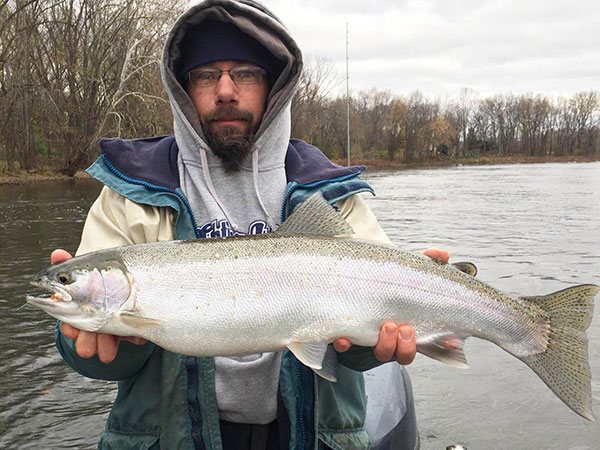By Louie Stout
 Winter Steelheading Can be Productive for Hardy Anglers
Winter Steelheading Can be Productive for Hardy Anglers
A dilemma for steelhead anglers occurs every winter: The St. Joseph River is full of steelhead, but it's snowy and it's cold.
How badly do you want to catch them?
Mike Jones of Mishawaka wants to catch them badly. Fishing's in his blood - year-round. When he's not chasing steelhead or walleyes in the winter, he's trying to outfox catfish or bluegill at other times of the year.
That's why he spends as much time as he can on the river and his success speaks for itself.
"Last year, my fishing partners and I caught 137 steelhead from late October through March," he said.
With more fish in the river this year, December through March should be even better.
If you can handle the weather.
"Last week, we caught 14," said Jones, who outside of an occasional walleye or mess of bluegill, releases everything he catches.
While he does most of his fishing at Berrien Springs, Mich., in the early winter, he says the Indiana pools on the St. Joe can be just as productive.
He fishes by boat most of the time which enables him to position himself over the deep holes the steelhead are using. Depth is relative, as some sections of the river may only be 10 feet or so.
"I target those deep runs in 10 to 20 feet of water when it's available, because that's where the fish hole up until the water warms above 40 degrees," he said. "You don't want slack water, but you don't want fast current, either."
Jones said he's caught as many as 15 in one hole, but 3-to-5 fish per hole is the norm, with most fish running in the 6-12 pound range.
"I'll fish a hole for about 15 minutes, and if I don't get a bite, I'm out of there and move to another spot," he said.
Jones uses a variety of lures, noting that the key is to get any bait close to the bottom where the fish are.
"You have to put a bait in front of the fish and fish slowly," he said. "The fish are lethargic and they will feed but they won't chase a bait like they do when the water is warmer."
His first choice is a Luhr Jenson Kwikfish, which is a diving body bait like the old Flat Fish, but it has unique fish-catching qualities, according to Jones.
"I had so much success with it last year that I bought $200 worth," he said. "Pink and silver have been the best colors."
Jones backtrolls the Kwikfish ever-so-slowly through the deep holes. The bait gets down to 14 feet but will run deeper with more line let out. He fishes it on 12-pound monofilament.
"I'd actually rather walk spawn through the holes, but the Kwikfish is so darn effective," he said. "The guys I fish with will fish spawn under a bobber, setting the bait just off the bottom. They catch fish, but the crankbait catches more."
While Jones doesn't mind fishing winter, he says he rarely goes when the air temperature is below 20 degrees and won't fish spawn bags when the temperature is below 25 degrees.
"The rod guides freeze up so much you constantly have to clean them out with your teeth," he said. "But the fish still bite."
You don't have to be on the water at daylight, either. He says that on days when the sun is out, the warmth of the rays warm up the surface and seem to get the fish biting better.
"But they will bite all day long if you're patient, fishing the rights spots and fishing slowly," he added.





